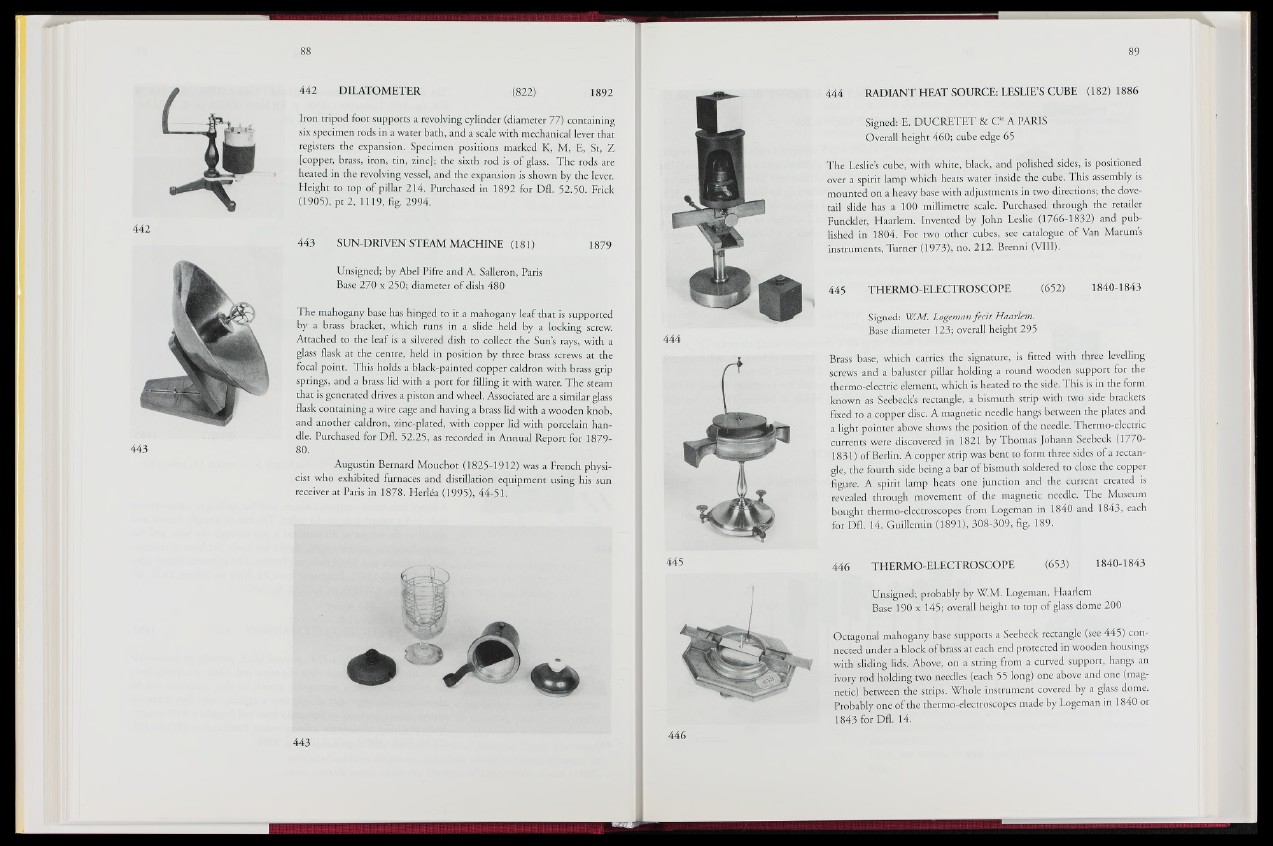
442 DILATOMETER (822) 1892
442
443
Iron tripod foot supports a revolving cylinder (diameter 77) containing
six specimen rods in a water bath, and a scale with mechanical lever that
registers the expansion. Specimen positions marked K, M, E, St, Z
[copper, brass, iron, tin, zinc]; the sixth rod is of glass. The rods are
heated in the revolving vessel, and the expansion is shown by the lever.
Height to top of pillar 214. Purchased in 1892 for Dfl. 52.50. Frick
(1905), pt 2, 1119,fig. 2994.
443 SUN-DRIVEN STEAM MACHINE (181) 1879
Unsigned; by Abel Pifre and A. Salleron, Paris
Base 270 x 250; diameter of dish 480
The mahogany base has hinged to it a mahogany leaf that is supported
by a brass bracket, which runs in a slide held by a locking screw.
Attached to the leaf is a silvered dish to collect the Sun’s rays, with a
glass flask at the centre, held in position by three brass screws at the
focal point. This holds a black-painted copper caldron with brass grip
springs, and a brass lid with a port for filling it with water. The steam
that is generated drives a piston and wheel. Associated are a similar glass
flask containing a wire cage and having a brass lid with a wooden knob,
and another caldron, zinc-plated, with copper lid with porcelain handle.
Purchased for Dfl. 52.25, as recorded in Annual Report for 1879-
80.
Augustin Bernard Mouchot (1825-1912)'was a French physicist
who exhibited furnaces and distillation equipment using his sun
receiver at Paris in 1878. Herlifa (1995), 44-51.
445
444 RADIANT HEAT SOURCE: LESLIE’S CUBE (182) 1886
Signed: E. DUCRETET & Cic A PARIS
Overall height 460; cube edge 65
The Leslie’s cube, with white, black, and polished sides, is positioned
over a spirit lamp which heats water inside the cube. This assembly is
mounted on a heavy base with adjustments in two directions; the dovetail
slide has a 100 millimetre scale. Purchased through the retailer
Funckler, Haarlem. Invented by John Leslie (1766-1832) and published
in 1804. For two other cubes, see catalogue of Van Marum’s
instruments, Turner (1973); no. 212. Brenni (VIII).
445 THERMO-ELECTROSCOPE (652) 1840-1843
Signed: W.M. Logeman fecit Haarlem.
Base diameter 123; overall height 295
Brass base, which carries the signature, is fitted with three levelling
screws and a baluster pillar holding a round wooden support for the
thermo-electric element, which is heated to the side. This is in the form
known as Seebeck’s rectangle, a bismuth strip with two side brackets
fixed to a copper disc. A magnetic needle hangs between the plates and
a light pointer above shows the position of the needle. Thermo-electric
currents were discovered in 1821 by Thomas Johann Seebeck (1770-
1831) of Berlin. A copper strip was bent to form three sides of a rectangle,
the fourth side being a bar of bismuth soldered to close the copper
figure. A spirit lamp heats one junction and the current created is
revealed through movement of the magnetic needle. The Museum
bought thermo-electroscopes from Logeman in 1840 and 1843, each
for Dfl. 14. Guillemin (1891), 308-309, fig. 189.
446 THERMO-ELECTROSCOPE (653) 1840-1843
Unsigned; probably by W.M. Logeman, Haarlem
Base 190 x 145; overall height to top of glass dome 200
Octagonal mahogany base supports a Seebeck rectangle (see 445) connected
under a block of brass at each end protected in wooden housings
with sliding lids. Above, on a string from a curved support, hangs an
ivory rod holding two needles (each 55 long) one above and one (magnetic)
between the strips. Whole instrument covered by a glass dome.
Probably one of the thermo-electroscopes made by Logeman in 1840 or
1843 for Dfl. 14.